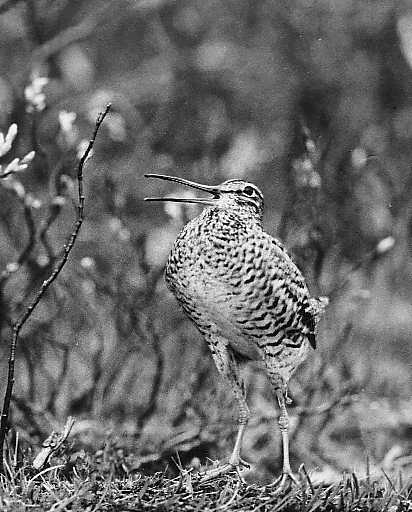
Studies of less familiar birds
Text and photographs by P0 Swanberg Sweden.
I found this text in British Birds Vol. 58 December 1965. If you just want to look at the plates. Wellcome !

The Great Snipe Gallinago media is decidedly larger than the Snipe Gallinago gallinago. Kolthoff (1896) found that it ranged in weight from 140 grams in thin specimens to 213 grams in a very fat one, while Snipe averaged only 120 grams; Niethammer (1942) quoted even lower figures for the latter species, 13 specimens of which (mostly collected in April) ranged from 86 to 121 grams. Further, Jägerskiöld and Kolthoff (1911-26) gave the wingmeasurement of the Great Snipe as 138-15 2 mm, and that of the Snipe as only 124-13 5 mm.
Size alone is of limited value in the field, however, and one of the two most important fieldcharacters is that the Great Snipe is more boldly spotted on the breast than the Snipe, and barred all over the flanks and the tibiae so that only a small area in the centre of the belly looks more or less unspotted (plates 72, 73 and 74). In the Snipe the pure white of the belly extends to the lower parts of the flanks and the tibiae (cf. the photograph by C. C. Doncaster, Brit. Birds, 53: plate 27a).
The second main fieldcharacter is the triangular white on the outer tail, which may be seen when the tail is fanned. The three outermost feathers on each side are largely white and the next two are broadly tipped with white (plates 75 and 76). Sometimes this may be seen when a Great Snipe flies up, and more often when it lands: after a flight it tends to drop vertically into dense vegetation such as willow scrub and the white then usually shows quite clearly when the tail is spread as a brake. When the bird is seen with a strong light behind it, the white of the tail stands right out. It should be remembered, however, that juveniles do not fully develop this white until after the moult in their first autumn. Incidentally, Great Snipe usually have 16 tailfeathers compared with the normal 14 of the Snipe, but both species are variable in this respect.
The flight of the Great Snipe is straight, not zigzagging or swaying. This species looks heavier than a Snipe when it is flushed, giving an impression of a small Woodcock Scolopax rusticola and it is usually silent. Its wingbeats do not seem so rapid as those of a Snipe. Seen from behind in level flight just over the top of the willow scrub, one of these birds has sometimes given me the impression of a Teal Anas crecca. In flight the bill is depressed to about 15° to 20° below the horizontal. In a good light the back looks not merely striped like that of a Snipe, but bright greenish contrasting with dark brown streaks. A black speculum bordered by the white tips of the wingcoverts and secondaries is usually conspicuous in flight and often striking on the ground (plates 75 and 77). When a Great Snipe is running through dense vegetation it holds its bill almost horizontal; otherwise the tip is slightly depressed.
The Great Snipe is known to breed in northern Scandinavia, Russia, northern Poland and western Siberia eastwards to the Yenisei. Up to a hundred years ago it was also numerous in suitable localities in southern and central Sweden. In the marshes around Lake Hornborga, for example, it used to occur in great numbers in the breeding season as well as in the autumn: Kolthoff (1896) wrote that in 1864 two hunters could easily shoot a hundred there in two days and thousands would still be left. Then, however, a rapid decrease began and in the last fifty years the species has nested only occasionally in central Sweden and only solitary individuals are infrequently observed there on migration. Such nesting as there is now in Sweden is restricted to a few places in the north. A similar decrease has occurred in other countries. In Russia, for instance, Alexejev (1956) quoted M. A. Menzbir as concluding that the decrease started at the beginning of the nineteenth century and added that the species is now a rare bird in many areas. This great decrease throughout the range has not been clearly explained, but hunting and drainage are probably the most important factors. It is sometimes thought that climatic changes may have played a part, but, if the decline in the nineteenth century were related to the decreasing spring and summer temperatures at that time, why was there not a corresponding recovery when the temperatures increased again this century, and why should the remaining strongholds now be in the cooler northern parts of the range?
Plates 72 - 79 were taken in central Swedish Lapland, in a valley above the tree limit where some tens of Great Snipe still breed in the willow zone. This valley is only slightly south of the Arctic Circle and so the light of the midnight sun just below the horizon makes allnight observation possible. This and the few other remaining breeding localities in Sweden correspond well with those described in earlier accounts when the species was said to breed everywhere that the habitat was suitable. The Great Snipe frequents vast marshy grounds with sphagnum covered tussocks and willow scrub, usually fed by numerous tiny streams from the mountain slopes above (plate 79). A considerable area of such marshy ground may be essential for this species, since it is apparently highly stimulated by, if not dependent on, a social display.
The display area is in the wetter part of the marshy area, but, in contrast to the Snipe Gallinago gailinago, the Great Snipe prefers drier ground for its nest and this tends to be fairly well concealed by dense herbs and willows (see Brit. Birds, 42: plates 33-35). On migration - that is in late August and the first two weeks of September in central Sweden it is found in the same sedgy marshes as the Snipe, and it also occurs in drier meadows.
Male Great Snipe congregate on a communal display ground each evening, just as Ruffs Philomachus pugnax do by day. In the mountain valley in Swedish Lapland where these photographs were taken, there are two known display grounds just over three miles apart. In 1961 one had 15 - 20 males and the other 12 - 15 in areas of about 65 x 75 and 50 x 65 yards respectively. Occasional display sounds may be heard far from the communal display ground in the daytime, but these do not indicate full display or a true display ground. On the contrary, they show that by day the males are spread well away from the display area.
Every male has several display stands on the communal ground and he alternates between them, usually running from one to another, but one spot generally seems to be the favourite. The postures and the accompanying sounds are described in the legends accompanying plates 72 - 78.
When the action reaches maximum intensity, the displaying snipe frequently jump five to eight feet in the air. These jumps either end at the starting point or move a bird a few yards to another stand on a different tussock. Now and again two birds jump vertically into the air together, breast to breast and bill to bill; loud wingbeats can be heard at these times, but I would not like to say that this is a real and intentional 'striking with wings' as suggested in The Handbook. After this ceremonial caper they usually sit peacefully near each other, sometimes at a distance of only a foot or two. More serious aggressive display may possibly occur and gentle chasing certainly does take place on occasion, but I have never seen two birds strike each other with their bills or anything else to suggest this. For example, at 00.57 hours on 23rd June 1961 two were 'fighting' close to my hide. They wielded their bills horizontally like spears, but, as usual, there was no real attacking in the air or on the ground, only fluttering breast to breast. It ended with their both dropping down only a foot apart; then one ran off about five feet and both began the drumming which is the culmination of the display (and which from a distance, as described on plates 73 and 74, sounds like a series of clicking noises).
The social character of the display is also shown by several birds taking short flights together over the scrub on the display ground when display is at its maximum. Two to four may take wing for 10 to 20 yards or more and then alight a short distance from each other. Sometimes one of these will break away from the others in flight and disappear to drier ground nearby: I suspect that this may be a female. Another interesting pattern in the communal display is when, after a lull, one bird begins drumming and this causes other males to start up in rapid succession. The drumming or clicking sounds thus spread like a wave over the display ground and one may then easily get the impression that the snipe have purposely stationed themselves in a long line (see The Handbook), but in my experience they are actually dispersed irregularly where there happen to be suitable display stands.
It is remarkably difficult to discover a display ground if one does not know its position in advance. One reason is that the males from a vast marshy area gather to a very limited part where they are fairly well concealed by scrub. Another is that the sounds carry only a short distance as little as a hundred yards in bad weather against the wind and only 200 - 250 yards (or slightly more for very good ears) in the best conditions. Yet another reason may be that the full communal display lasts for only a few hours around midnight in northern Scandinavia or at dawn and dusk further south. In June there is fairly good daylight all the night in northern Sweden, as is demonstrated by the fact that all the photographs on plates 72 - 78 were taken without artificial illumination. At midnight photographs could still be taken at f5.6 and 1/25th second, even with an overcast sky.
As Collett (1893) pointed out, the males are not usually seen at or around the display ground before the display hours, nor are they normally seen to arrive or leave. On 18th June 1961, for example, I reached the display ground at 13.45 hours. No Great Snipe were in evidence. I watched the whole area continuously from my hide on the outer edge, but did not see any flying snipe arrive. Nevertheless, the display began about 30 yards from my hide at 17.15 hours and soon 15 - 20 males were involved. After the "lek" begins, the display flights already described may be seen now and then, but I myself have not observed the 'arrival of birds flying low with a special slow wingaction and producing a quite loud "wuff, wuff, wuff", with wings' ascribed to R. Rohweder in The Handbook. Evidently they usually run to the display ground and leave it in the same way, but further critical observations are still needed.
And now wellcome to the plates of this rare bird.
Plate inledning2
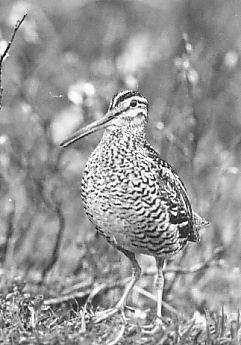
Great Snipe Gallinago media at display stand, Swedish Lapland, 23.15 hours, 22nd June 1961. This male is preparing for the more spectacular postures, making a low bubbling noise, klokloklokio .... which is not audible at more than a few yards. Sometimes he may jump into the air from this posture, alight only two or three feet away and then go on 'bubbling'. The twittering described on plate 73 may also be used for a while as an introduction to the full display. Compare the boldly spotted and barred underparts (only the very centre of the belly is almost clear) with those of the Snipe Gallinago gallinago, which are much less heavily marked (see for example, Brit. Birds, 53: plate 27a) (pages 504-508)
Plate spel4

Great Snipe Gallinago media starting display, Swedish Lapland, 21.52 hours, 18th June 1961. The male begins the display proper by rising on his toes, stretching his neck, pointing his bill slightly upwards and also raising his tail stiffly. A moment later he lifts his body in a peculiar upright position, straining his breast upwards and forwards so that his neck again seems drawn in and his chin seems to be resting on his breast. With open bill he produces a twittering call, bipp-bipp-bippbippbipp . . . , and this runs into a clicking or drumming sound, klu-kee-kekekekeke . . . . stressed at the third syllable and then decreasing, which is the culmination of the display. This photo was taken at the moment when the drumming sound began. Note the vibrating flanks and wings.
Plate inledning2.
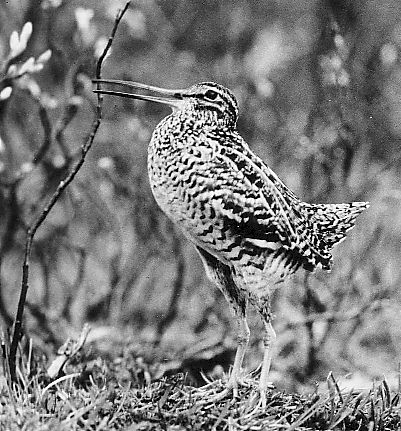
Great Snipe Gallinago media uttering the drumming or clicking sound, Swedish Lapland, 21.08 hours, 18th June 1961. Observe the vibration of his upper mandible. This is the noise that reveals the display at a distance. When it is not especially close it may be compared with the kind of sound that one produces by drawing one's finger along a horn comb. Under good conditions it can be heard by an experienced observer at a distance Of 200-250 yards.
Plate vingfas
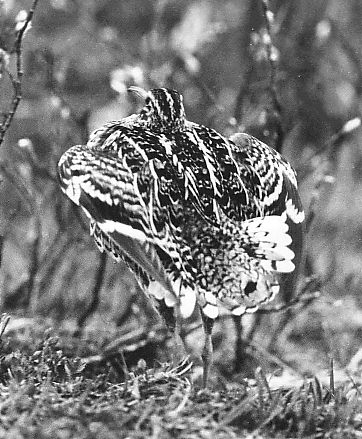
Great Snipe Gallinago media during later stages of display, Swedish Lapland, 21.49 hours, 18th June 196 1. The clicking or drumming sound develops into a vibratory, whizzing call which fades off at the end. In passing from the clicking to the whizzing he spreads his wings once or twice, fans his tail and displays the white of his outer tailfeathers. This photo shows such a moment, seen from behind, when his bill is still wide open (the twitching upper mandible is just visible here). Note the conspicuously striped wings.
Plate vingfas
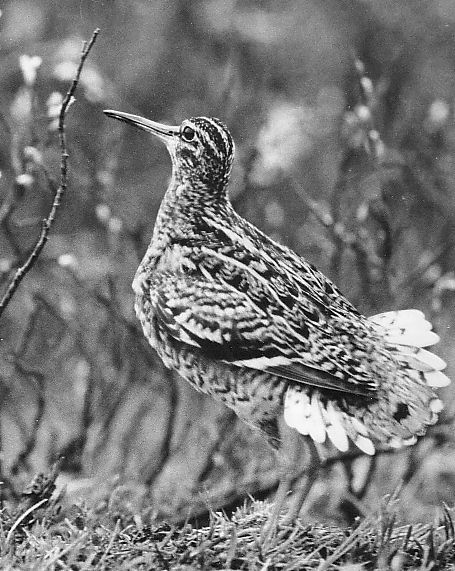
Great Snipe Gallinago media display, Swedish Lapland, 21.51 hours, 17th June 1961. At the moment when the male fans his tail, he keeps it more or less horizontal; then he depresses it, still forming a conspicuous white signal. He droops his body simultaneously, while keeping his head in the same position in relation to the ground, with the result that his neck is again stretched but for a moment still puffed up as the whizzing sound ends. This photo was taken just then. Note that the three outer tailfeathers are mainly white and that the next two have white tips. Great Snipe also show these white triangles when they jump into the air at the 'lek' or when thev drop down to cover.
Plate slutfas2
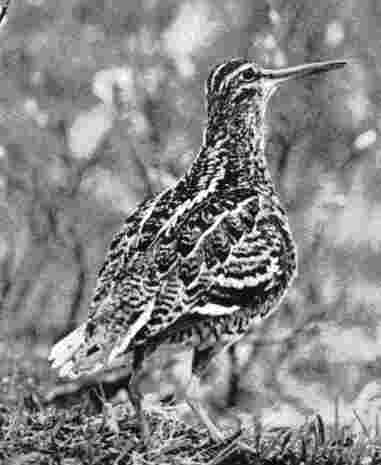
Plate 77. Above, Great Snipe Gallinago media at end of display, Swedish Lapland, 21.5 3 hours, 18th June 196 1. When he has completed all the different postures and sounds, he closes his tail and, within a few seconds, is quite relaxed for a moment or for some while before this chain of display actions begins again. Note the two light wingbars bordering the black speculum. Left, showing length of bill in relation to head: it is shorter and slightly stouter than that of the Snipe Gallinago gallinago (cf. Brit. Birds, 53: plate 27a; and 55: plate 82).
Plate vilofas
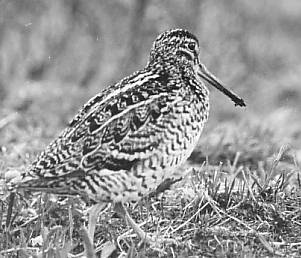
Great Snipe Gallinago media when display is over, Swedish Lapland, 02.52 hours, 23rd June 1961. Near the Arctic Circle the inclination to display fades one or two hours after midnight. The male, still at his tussock, relaxes and puts his beak into his feathers, but the display impulse may not have entirely disappeared. Sometimes a lowvoiced bubbling or twittering may be heard from him in this position, or a neighbour's drumming may suddenly cause a further outburst even though he seems relaxed: he becomes active again, rises on his toes, raises his breast and starts the drumming call. When the display impulse has faded finally, he begins feeding, probing the soil on his display ground. This photo was taken at such a moment; note the mud on his bill.
Plate
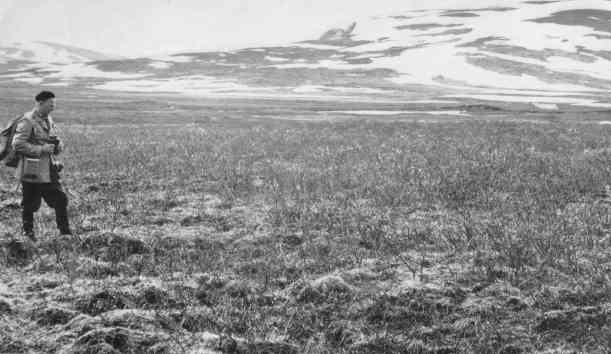 Sveipa
Sveipa
Alexejev A. F. (1956 'On the biology and occurrence of the Great Snipe (Capella media
Latham) in the flooded area at the river Oka'. Zoologiceskij Zurnal, 35:1422 (In
Russian).
Collett, R. (1893). Mindre Meddelelser vedr. Norges Fuglefauna i Aarene 1881 - 92 Nyt Mag. f. Naturv. 35: 1-387.
Jägerskiöld, L A, and Kolthoff G. (1911-26): Nordens Fåglar. Stockholm.
Kolthoff G. (1896): Vårt Villebråd. Stockholm.
Niethammer, G. (1942): Handbuch der Deutschen Vogelkunde. Leipzig. vol. 3.
Witherby H. F., et al. (1940): The Handbook of British Birds. London. vol. 4.